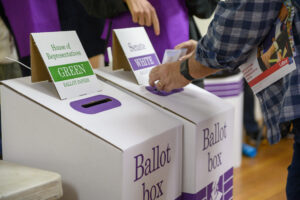by Richard Denniss
[Originally published on The Guardian Australia, 02 May 2019]
Australians are asked to either vote ‘above the line’ in the Senate by expressing a preference for at least six political parties, or vote ‘below the line’ by expressing a preference for at least 12 individual candidates. Photograph: Paul Crock/AFP/Getty Images
You can’t name your child Anzac, King or G-Bang in Australia. But imagine you wanted to, and some silly regulation wouldn’t let you use your first preference. Would you try for your second preference, or would you give up and let an unnamed bureaucrat name your kid for you?
Most people understand the concept of preferences. Most people are pretty clear about the foods they like the most and hate the most, just as they are pretty clear about the football teams, movies and hairstyles they like and hate. Preferences aren’t complicated, they are simply your choices.
But because of Ricky Muir (remember him?) we have made the way we express our democratic preferences very complicated. So complicated in fact, the head of the Australian Electoral Commission doesn’t even seem to know how it works.
Before explaining how preferential voting does work, first I have to make you care. Here goes:
Preferential voting could have stopped George W Bush from becoming US president and in turn, prevented the war in Iraq and the detention camp at Guantánamo Bay. But because the US doesn’t have preferential voting, we got stuck with both. Do you care yet?
In US presidential elections you only get one choice, and in the 2000 election US voters had to choose between Bush, Al Gore or an independent such as environmentalist and consumer rights campaigner Ralph Nader. To cut a long story short, the election went to the wire and after a long recount Bush got 537 more votes than Gore in the key state of Florida – which won him the election.
So what’s this got to do with preferences? Heaps. 562 Floridians voted for the Socialist Workers party. If they had been able to express a “preference” for Gore over Bush, then the election result could’ve been quite different. More significantly, 97,488 Floridians voted for Nader. Again, if they’d been able to express a second preference, then the election result, and the world, would likely look quite different. But they couldn’t and it doesn’t.
The US has a first-past-the-post system which simply means the candidate who gets the most primary votes wins. But luckily in Australia we have a system of “preferential” voting where voters express not just who they most want to be elected, but their second choice, their third choice and so on.
Which brings me back to the current confusion about preferential voting in Australia.
Silence matters in a democracy. Abstaining from a crucial vote can be decisive
In the lead-up to the 2016 double-dissolution federal election, the government passed new legislation which introduced “optional preferential” voting for the Senate. While lots of Australians were already a bit confused about how Senate voting worked, the new system has confused people quite a bit more. So much so that even the man responsible for overseeing our elections, the Australian electoral commissioner, Tom Rogers, either misspoke or misled the public when trying to explain the new system on the ABC this week.
So how does Senate voting work?
As of 2016 it’s up to you to decide how many of the parties or candidates you would like to express an opinion about. Under the new laws you are asked to either vote “above the line” by expressing a preference for AT LEAST six political parties or vote “below the line” by expressing a preference for AT LEAST 12 individual candidates.
Let’s take the New South Wales Senate ballot paper as an example. In NSW there are 105 candidates from 35 different parties seeking the six available Senate seats. If you vote above the line by placing a one next to the name of your favourite party, a two next to your second-favourite party and so on down to a six, you can stop there if you like. But if you stop at six you are saying that you have “no preference” about who among the remaining 29 parties gets elected. That’s a big call!
The NSW Liberal party are issuing how-to-vote cards that advise voters as follows:
1. Liberal and Nationals
2. United Australia party (Clive Palmer’s party)
3. Christian Democrats (Fred Nile’s party)
4. Liberal Democrats
5. Small Business party
6. Australian Conservatives (Cory Bernardi’s party)
But after that – silence. Despite the fact the Liberals talk incessantly about how “extreme” the Greens are, the NSW Liberal party is recommending that voters express no preference as to whether a Greens or an ALP candidate is elected. Similarly, the NSW Liberals are advising their voters to express no preference about whether it’s better for Fraser Anning’s party to be in the Senate or the Australian Democrats.
There’s nothing hypothetical about this. The race to be elected to the sixth Senate seat is often close and often goes to preferences, so if a million NSW Liberal voters express no preference for whether that last Senate seat goes to Anning or the ALP, then Anning’s chances improve significantly. Silence matters in a democracy. Abstaining from a crucial vote can be decisive.
You don’t just have a say about who will be put into the Senate, you also have a say in who to keep out
In the 2016 Senate election – the first held under the new rules – we know that of the people who voted “above the line” only 6% of voters went beyond the minimum six preferences.
We also know that half of all ballot papers had some share of their vote “wasted” by not continuing to number to the end of the ballot paper. At some point in the count, their ballots ran out of preferences and “exhausted”, letting other people’s preferences decide who was elected. In total, these people exhausted 7.5% of the national vote.
If we could identify those voters and ring to ask if they had a preference between One Nation and the Greens, I reckon most would have one.
The new voting system was rushed in before the last election with little time to explain it to voters, but that haste can’t explain why, three years later, the Australian electoral commissioner still couldn’t clearly explain how it works. But he’s not alone. According to polling by the Australia Institute, when provided with the same instructions as on the Senate voting ballot paper, nearly half of Australians think giving someone their sixth preference is the same as putting them last, when in reality they are putting them above every box they leave blank. The only way to “put someone last” is to put a number in every box.
No voting system is perfect. The first-past-the-post system gave the world George W Bush, our old Senate system elected Muir on a primary vote of 0.5% and our new system gave us Malcolm Roberts and Anning. Idiosyncrasies aside, the voting system we use should be well understood and it’s clear that our new one isn’t.
If you don’t really care which of the parties that you hate gets elected, then our new voting system means you are free to simply vote for the parties you like and let others decide the rest.
But if you have a preference about which party you most want to keep out of the Senate then it’s up to you to say so by listing your preferences for ALL of the parties. It might be frustrating choosing among the least worst, but just because someone won’t let you call your kid G-Bang, King or Anzac doesn’t mean you have to let someone else name your kid Pinocchio.
All elections matter, and all preferences matter. You don’t just have a say about who will be put into the Senate, you also have a say in who to keep out – but only if you ignore the electoral commissioner and express as many preferences as there are candidates. Don’t stop at your six favourites. Let those counting the votes know who you think the absolute worst is as well.
Richard Denniss is chief economist at the Australia Institute
Between the Lines Newsletter
The biggest stories and the best analysis from the team at the Australia Institute, delivered to your inbox every fortnight.
You might also like
Full preferential voting means you can’t waste your vote
Full preferential voting is a proud Coalition reform – one that benefits every political persuasion Compulsory voting and full preferential voting make up the backbone of Australian democracy, and protect us from voter suppression and disengagement seen in other countries. We owe both to the parties of the centre-right, what would become the Liberal–National Coalition.
The rise of early voting in Australian elections
Are voters missing out on more than their democracy sausage?
Australians should be proud of our preferential voting, but there is an alternative
A record number of Australians voted for independents and minor parties at the most recent federal election election.



